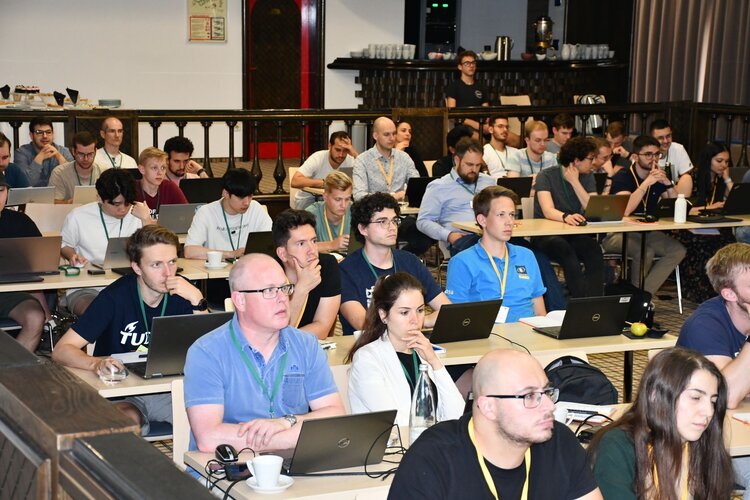
Copernical Team
Jetting into space
 Image:
Jetting into space
Image:
Jetting into space Leo P (NIRCam image)
 Image:
Leo P (NIRCam image)
Image:
Leo P (NIRCam image) Satnav summer school open for registrations

Are you a young researcher in the field of satellite navigation? Learn from top-notch experts and expand your network at this year’s ESA-JRC International Summer School on Global Navigation Satellite Systems, taking place this July in Arachova, Greece.
Before and after space
 Image:
Before and after space
Image:
Before and after space Clouds play key role in moderating Earth's surface warming
 McGill University researchers have revealed that changes in cloud cover are helping to slightly counteract global warming. While greenhouse gases continue to drive temperatures upward, a reduction in low-cloud cover over land has contributed to a small decrease in the amount of heat retained near the Earth's surface.
"We started this research to observationally verify the increase of green
McGill University researchers have revealed that changes in cloud cover are helping to slightly counteract global warming. While greenhouse gases continue to drive temperatures upward, a reduction in low-cloud cover over land has contributed to a small decrease in the amount of heat retained near the Earth's surface.
"We started this research to observationally verify the increase of green Solar Observatory sees coronal loops flicker before big flares
 For decades, scientists have tried in vain to accurately predict solar flares - intense bursts of light on the Sun that can send a flurry of charged particles into the solar system. Now, using NASA's Solar Dynamics Observatory, one team has identified flickering loops in the solar atmosphere, or corona, that seem to signal when the Sun is about to unleash a large flare.
These warning signs
For decades, scientists have tried in vain to accurately predict solar flares - intense bursts of light on the Sun that can send a flurry of charged particles into the solar system. Now, using NASA's Solar Dynamics Observatory, one team has identified flickering loops in the solar atmosphere, or corona, that seem to signal when the Sun is about to unleash a large flare.
These warning signs NASA celebrates Edwin Hubble's discovery of a new universe
 For humans, the most important star in the universe is our Sun. The second-most important star is nestled inside the Andromeda galaxy. Don't go looking for it - the flickering star is 2.2 million light-years away, and is 1/100,000th the brightness of the faintest star visible to the human eye.
Yet, a century ago, its discovery by Edwin Hubble, then an astronomer at Carnegie Observatories,
For humans, the most important star in the universe is our Sun. The second-most important star is nestled inside the Andromeda galaxy. Don't go looking for it - the flickering star is 2.2 million light-years away, and is 1/100,000th the brightness of the faintest star visible to the human eye.
Yet, a century ago, its discovery by Edwin Hubble, then an astronomer at Carnegie Observatories, Fresh, direct evidence for tiny drops of quark-gluon plasma
 A new analysis of data from the PHENIX experiment at the Relativistic Heavy Ion Collider (RHIC) reveals fresh evidence that collisions of even very small nuclei with large ones might create tiny specks of a quark-gluon plasma (QGP). Scientists believe such a substance of free quarks and gluons, the building blocks of protons and neutrons, permeated the universe a fraction of a second after the B
A new analysis of data from the PHENIX experiment at the Relativistic Heavy Ion Collider (RHIC) reveals fresh evidence that collisions of even very small nuclei with large ones might create tiny specks of a quark-gluon plasma (QGP). Scientists believe such a substance of free quarks and gluons, the building blocks of protons and neutrons, permeated the universe a fraction of a second after the B Sierra Space resilient GPS Satellite Program achieves major development milestone
 Sierra Space, a leading commercial space enterprise and defense technology provider, has announced a significant milestone for its Resilient GPS (R-GPS) program with the successful completion of the Systems Requirements Review (SRR). This accomplishment marks a critical step forward in the initiative, which aims to enhance the resilience of U.S. satellite infrastructure to benefit both civilia
Sierra Space, a leading commercial space enterprise and defense technology provider, has announced a significant milestone for its Resilient GPS (R-GPS) program with the successful completion of the Systems Requirements Review (SRR). This accomplishment marks a critical step forward in the initiative, which aims to enhance the resilience of U.S. satellite infrastructure to benefit both civilia BlackSky secures $200M Luno B contract
 BlackSky Technology Inc. (NYSE: BKSY) has been named as a key vendor by the National Geospatial-Intelligence Agency (NGA) for its $200 million Luno B commercial data indefinite delivery, indefinite quantity (IDIQ) contract.
The Luno B initiative is designed to provide the national security sector with rapid access to high-quality commercial geospatial intelligence (GEOINT). The contract su
BlackSky Technology Inc. (NYSE: BKSY) has been named as a key vendor by the National Geospatial-Intelligence Agency (NGA) for its $200 million Luno B commercial data indefinite delivery, indefinite quantity (IDIQ) contract.
The Luno B initiative is designed to provide the national security sector with rapid access to high-quality commercial geospatial intelligence (GEOINT). The contract su 































